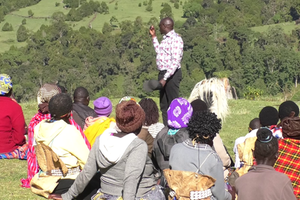Women, youth get Sh12m boost to fight climate change

Homa Bay Governor Gladys Wanga poses for a photo with youth and women groups that benefited from a Sh12.3 million grant to undertake tree seedling production under the Financing Locally-Led Climate Action (FLLoCA) programme on November 15, 2024.
What you need to know:
- Homa Bay has a forest cover of 3.1 per cent and a tree cover of 10.4 per cent.
Across Kenya, vast areas of land are bare with no vegetation.
In some regions, tree cover continues to diminish at an alarming rate, with illegal logging blamed as the contributing factor to reduced forest sizes.
This is dangerous to the environment as increased greenhouse gases due to deforestation provoke climate change.
Trees play a significant role in mitigating the impacts of climate change on a global scale by absorbing carbon dioxide from the atmosphere through photosynthesis.
This in turn reduces greenhouse gases when trees take in carbon dioxide from the atmosphere and store it as wood. This process, known as carbon sequestration, is essential in the long-term fight against climate change and its impact on the globe.
Homa Bay is one of the counties taking the lead in increasing forest cover to help reverse the effects of climate change and reduce the risk of floods, droughts, and other extreme weather events.
The county has disbursed Sh12.3 million to 82 women and youth groups to support them in growing tree seedlings.
Governor Gladys Wanga said the initiative, which is supported by the Financing Locally-Led Climate Action (FLLoCA) programme, will help in restoration of the county’s fragile forest cover.
According to Kenya Forest Service (KFS), Homa Bay has a forest cover of 3.1 per cent and a tree cover of 10.4 per cent.
Meanwhile, 14,000 hectares of land have been gazetted as forest areas.
Speaking when she gave out the cheques to the groups, Ms Wanga noted: "Our once thriving ecosystems face multiple pressures from rapid population growth, deforestation, expansion into marginal lands, soil erosion, and drying riverbanks due to sand harvesting and overgrazing.”
She added that forests like Kodera, Gembe, Gwassi and other water sources are constantly under threat from human activities such as illegal logging and encroachment.
She explained that environmental stress has diminished the county's natural resources and compromised agricultural activities, which are threatened by prolonged dry spell and high temperatures.
To address the challenges, the county government engaged partners and managed to secure support from the climate resilience investment grant under the FLLoCA programme.
The funding aims to finance priority climate resilient projects as outlined in the Homa Bay County Climate Change Action Plan for 2023 to 2027.
Ms Wanga said her administration has put a special focus on water, agriculture and the environment.
"These investments are strategically designed to help communities adapt to the impacts of climate change, with special attention given to the inclusion of women, youth and people living with disabilities," the governor said.
Before the funds were disbursed, the county government undertook a public participation exercise.
Ms Wanga said one of the most prioritised interventions, which was identified during community engagements, was tree planting.
She noted that different communities recognised the urgent need to restore landscapes, preserve biodiversity, and mitigate the impacts of climate change.
"To support this goal, we launched a call for proposals, encouraging youth and women groups across all our 40 wards to submit their plans for establishment of community tree nurseries. I am happy to announce that a total of 82 groups have been selected, with each ward having two groups to manage these tree nurseries.
“The groups have been trained in tree nursery establishment and management, ensuring that they are well equipped with knowledge and skills to cultivate high-quality seedlings suited to our local ecological conditions.”
Each group received a grant of Sh150,000 to facilitate the establishment and management of these nurseries, with an ambitious target of propagating at least 100,000 tree seedlings per group.
Ms Wanga said by the onset of the long rains in 2025, Homa Bay anticipates to have eight million seedlings ready for planting across the county.
She said the initiative will help rehabilitate degraded lands, restore natural ecosystems and increase biodiversity.
She added that the programme is a catalyst for economic growth, social cohesion, and climate resilience.
"We envision a county where our youth, women, and communities thrive while contributing to the health of our planet. The groups undertaking this programme carry the hopes of our community and the future of our environment depends on their dedication.”
"It will also improve soil fertility and water retention across the county. Our aim is to plant indigenous and climate-resilient trees, which will ensure that our interventions support native flora and fauna and contribute to increased carbon sequestration, a vital tool in mitigating climate change.”
Beneficiaries of the programme will also enjoy economic benefits as the establishment of tree nurseries will generate employment. Overall, the initiative will help in sequestration of carbon dioxide, thereby reducing overall carbon footprint.
"This is not just a local endeavour, but a contribution to a larger global effort to help climate change and ensure a sustainable future for us all," Governor Wanga said.
However, implementers of the programme are anticipating some challenges such as traditional seed collection methods - gathering seeds from felled trees - which limits genetic vigor.
According to Ms Wanga, Homa Bay relies on tree seedlings from neighbouring counties. “The county faces limitations in terms of quality and genetic diversity. By establishing local community nurseries, we aim to enhance seedling quality, increase local availability, and reduce dependence on external sources.”
In order to address the challenges, the county government is involving local communities in every stage, building respect for indigenous knowledge while introducing sustainable practices.
[email protected]





